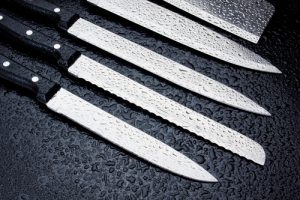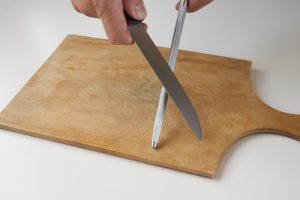Knives to butchers are what hammers are to builders. And mastering knife skills is an essential part of acquiring crucial ingredients in cooking. Almost every recipe you use for any type of cooking will require some form of knife work. Whether it’s deboning fish, mincing fresh herbs, or cutting raw meat, you need to know how to handle knives safely and properly.

Here are the essential tools you’ll need in the different ways of food preparation.
Chopping Board
Wood, bamboo, composite, plastic – chopping boards can be made of many different materials. We recommend that you never use the same chopping board for meats and vegetables. Keep a small one for chopping up herbs and small fruits and vegetables, a medium-sized one for aptly sized vegetables and fruits, and a larger one for meats and seafood. Plastic boards generally last a long time and are available in a variety of sizes. They are also dishwasher-friendly and are easy to clean. However, they tend to slide around the countertop. If they do, keep them in place by moistening the countertop before putting the board on it. You can also use a dampened kitchen towel and place it under the board. Don’t use any hard surface like granite or glass; they have a slippery surface and can dull your knife.
Knives
At a butchers shop, knives are one of the essential tools they keep. Each type of knife is crafted to do a particular task. If you want to have knife skills like a pro, consider having these knives at home and learning what they are made for.
Chef’s Knife
If you don’t want to have multiple knives, then having one good quality chef knife should be enough. They are multi-purpose (julienne, slice, mince, dice) and can handle most cutting jobs involving fruits, vegetables, and meats. They are typically eight to ten inches long.
Boning Knife
As the name implies, boning knives are made to cut around the bone – not through it. They come at about five to six inches long with either a stiff or semi-flexible blade. Stiff blades are used for accurate cuts. Semi-flexible blades, on the other hand, let you get incredibly close to the bone.
Serrated Knife
Typically used for slicing bread, serrated knives can also cut through food items that have hard exteriors and soft interiors. It can also slice anything that only needs minimal grip to cut through, such as tomatoes, any citrus fruits, ripe melons, and even chocolates and cakes.
Paring Knife
A small utility knife, paring knives are best used for peeling, slicing, and chopping food items that need accurate and detailed cutting.
Honing Steel

You might have heard the saying that a dull knife is a dangerous knife – and butchers and chefs live by that rule. Since knives are one of the most used tools in the kitchen, they can get dull quite fast. Using dull knives is extremely dangerous because you need to exert more effort to make a dull blade work. Doing so is prone to slipping and missing and can cause injuries. A sharp knife equates to you having more control and fewer misses so that you can get safe, correct, and consistent slices.
To fix dull knives, you must have a honing steel. It realigns the fine part of the blade, which should be utilized every time you use a knife. To safely and adequately steel the knife, place the knife vertically on the chopping board and securely gripping the handle. Start honing at the heel of the blade and slide downward at about a 20-degree angle using the length of the rod. Repeat this process on the other side. Do each side for about five to six times. If you still can’t get sharp slices, employ the services of a professional knife company. It’s also advisable to have your knives professionally sharpened at least once a year.
Useful Tips
- Don’t put your knife in the sink with soapy water as you won’t be able to see it as you reach in the water.
- Don’t put your knives in the dishwasher; wash them by hand.
- Store your knives in a safe and secure pot. Don’t put them in kitchen drawers with the other utensils or in spots that children can easily reach.